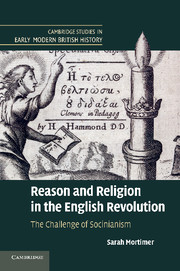Book contents
- Frontmatter
- Contents
- Acknowledgements
- Abbreviations and conventions
- Introduction
- 1 The Socinian challenge to Protestant Christianity
- 2 Socinianism in England and Europe
- 3 The Great Tew Circle: Socinianism and scholarship
- 4 Royalists, Socinianism and the English Civil War
- 5 Socinianism and the Church of England
- 6 Reason, religion and the doctrine of the Trinity
- 7 Anti-Trinitarianism, Socinianism and the limits of toleration
- 8 Socinianism and the Cromwellian Church settlement
- Conclusion: the legacy of Socinianism
- Bibliography
- Index
5 - Socinianism and the Church of England
Published online by Cambridge University Press: 05 May 2010
- Frontmatter
- Contents
- Acknowledgements
- Abbreviations and conventions
- Introduction
- 1 The Socinian challenge to Protestant Christianity
- 2 Socinianism in England and Europe
- 3 The Great Tew Circle: Socinianism and scholarship
- 4 Royalists, Socinianism and the English Civil War
- 5 Socinianism and the Church of England
- 6 Reason, religion and the doctrine of the Trinity
- 7 Anti-Trinitarianism, Socinianism and the limits of toleration
- 8 Socinianism and the Cromwellian Church settlement
- Conclusion: the legacy of Socinianism
- Bibliography
- Index
Summary
Defending the monarchy from the rebellious forces of the Parliamentarians and Covenanters, Hammond found Socinian ideas helpful, but he soon realised that they could be put to better use defending the Church of England. From the middle of the 1640s, Hammond devoted his time to producing tracts and pamphlets in support of the Church of England and its episcopal structure. In these works, he continued to develop his ideas about the relationship between Christianity and nature, but he did so in the context of a discussion about the future of the Church, rather than the legitimacy of resistance. Of course, Hammond rejected many of the tenets of the Socinians, and his faith had a place for the doctrines of the Trinity and the atonement. But he did begin to draw some ideas previously associated with Socinianism into the theological centre of the Church of England, on the grounds that these would strengthen the Church against attacks from its critics. In particular, he wanted to show that the Church's doctrines and government must be based upon the law of Christ, and not the law of nature. How and why he did so will be the focus of this chapter.
Hammond's writing is often characterised as Arminian, but in this chapter we will see why it echoes more closely the thought of Socinus than the writing of Jacob Arminius.
- Type
- Chapter
- Information
- Reason and Religion in the English RevolutionThe Challenge of Socinianism, pp. 119 - 146Publisher: Cambridge University PressPrint publication year: 2010



